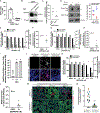Host protein kinases required for SARS-CoV-2 nucleocapsid phosphorylation and viral replication
- PMID: 36282911
- PMCID: PMC9830954
- DOI: 10.1126/scisignal.abm0808
Host protein kinases required for SARS-CoV-2 nucleocapsid phosphorylation and viral replication
Abstract
Multiple coronaviruses have emerged independently in the past 20 years that cause lethal human diseases. Although vaccine development targeting these viruses has been accelerated substantially, there remain patients requiring treatment who cannot be vaccinated or who experience breakthrough infections. Understanding the common host factors necessary for the life cycles of coronaviruses may reveal conserved therapeutic targets. Here, we used the known substrate specificities of mammalian protein kinases to deconvolute the sequence of phosphorylation events mediated by three host protein kinase families (SRPK, GSK-3, and CK1) that coordinately phosphorylate a cluster of serine and threonine residues in the viral N protein, which is required for viral replication. We also showed that loss or inhibition of SRPK1/2, which we propose initiates the N protein phosphorylation cascade, compromised the viral replication cycle. Because these phosphorylation sites are highly conserved across coronaviruses, inhibitors of these protein kinases not only may have therapeutic potential against COVID-19 but also may be broadly useful against coronavirus-mediated diseases.
Conflict of interest statement
Competing interests:
Duke University has filed for intellectual property protection regarding the use of SRPK inhibitors in the treatment of COVID-19. L.C.C. is a founder and member of the board of directors of Agios Pharmaceuticals and is a founder and receives research support from Petra Pharmaceuticals. L.C.C. is an inventor on patents (pending) for Combination Therapy for PI3K-associated Disease or Disorder, and The Identification of Therapeutic Interventions to Improve Response to PI3K Inhibitors for Cancer Treatment. L.C.C. is a co-founder and shareholder in Faeth Therapeutics. T.M.Y. is a stockholder and on the board of directors of DESTROKE, Inc., an early-stage start-up developing mobile technology for automated clinical stroke detection. O.E. is a founder and equity holder of Volastra Therapeutics and OneThree Biotech. O.E. is a member of the scientific advisory boards of Owkin, Freenome, Genetic Intelligence, Acuamark, and Champions Oncology. O.E. receives research support from Eli Lilly, Janssen, and Sanofi. R.E.S. is on the scientific advisory board of Miromatrix Inc. and is a consultant and speaker for Alnylam Inc. P.R.T serves as an acting CEO of Iolux Inc. P.R.T. serves as a consultant for Cellarity Inc. and Surrozen Inc. P.R.T. receives research support from United Therapeutics Inc. G.G. receives research funds from IBM and Pharmacyclics and is an inventor on patent applications related to MuTect, ABSOLUTE, MutSig, MSMuTect, MSMutSig, MSIdetect, POLYSOLVER, and TensorQTL. G.G. is a founder, consultant, and holds privately held equity in Scorpion Therapeutics. S.C. is a co-founder of OncoBeat LLC. The other authors declare that they have no competing interests.
Figures




Similar articles
-
Glycogen synthase kinase-3 regulates the phosphorylation of severe acute respiratory syndrome coronavirus nucleocapsid protein and viral replication.J Biol Chem. 2009 Feb 20;284(8):5229-39. doi: 10.1074/jbc.M805747200. Epub 2008 Dec 23. J Biol Chem. 2009. PMID: 19106108 Free PMC article.
-
Targeting the coronavirus nucleocapsid protein through GSK-3 inhibition.Proc Natl Acad Sci U S A. 2021 Oct 19;118(42):e2113401118. doi: 10.1073/pnas.2113401118. Epub 2021 Sep 30. Proc Natl Acad Sci U S A. 2021. PMID: 34593624 Free PMC article.
-
SARS-CoV-2 genomes from Saudi Arabia implicate nucleocapsid mutations in host response and increased viral load.Nat Commun. 2022 Feb 1;13(1):601. doi: 10.1038/s41467-022-28287-8. Nat Commun. 2022. PMID: 35105893 Free PMC article.
-
Glycogen synthase kinase-3: A putative target to combat severe acute respiratory syndrome coronavirus 2 (SARS-CoV-2) pandemic.Cytokine Growth Factor Rev. 2021 Apr;58:92-101. doi: 10.1016/j.cytogfr.2020.08.002. Epub 2020 Aug 25. Cytokine Growth Factor Rev. 2021. PMID: 32948440 Free PMC article. Review.
-
GSK-3 Inhibition as a Therapeutic Approach Against SARs CoV2: Dual Benefit of Inhibiting Viral Replication While Potentiating the Immune Response.Front Immunol. 2020 Jun 26;11:1638. doi: 10.3389/fimmu.2020.01638. eCollection 2020. Front Immunol. 2020. PMID: 32695123 Free PMC article. Review.
Cited by
-
Hippo signaling pathway regulates Ebola virus transcription and egress.Nat Commun. 2024 Aug 13;15(1):6953. doi: 10.1038/s41467-024-51356-z. Nat Commun. 2024. PMID: 39138205 Free PMC article.
-
Modulation of biophysical properties of nucleocapsid protein in the mutant spectrum of SARS-CoV-2.Elife. 2024 Jun 28;13:RP94836. doi: 10.7554/eLife.94836. Elife. 2024. PMID: 38941236 Free PMC article.
-
SARS-CoV-2 nucleocapsid protein directly prevents cGAS-DNA recognition through competitive binding.Proc Natl Acad Sci U S A. 2025 Jul;122(26):e2426204122. doi: 10.1073/pnas.2426204122. Epub 2025 Jun 23. Proc Natl Acad Sci U S A. 2025. PMID: 40549905 Free PMC article.
-
Protein arginine methylation in viral infection and antiviral immunity.Int J Biol Sci. 2023 Oct 24;19(16):5292-5318. doi: 10.7150/ijbs.89498. eCollection 2023. Int J Biol Sci. 2023. PMID: 37928266 Free PMC article. Review.
-
Diversity of short linear interaction motifs in SARS-CoV-2 nucleocapsid protein.mBio. 2023 Dec 19;14(6):e0238823. doi: 10.1128/mbio.02388-23. Epub 2023 Nov 29. mBio. 2023. PMID: 38018991 Free PMC article.
References
Publication types
MeSH terms
Substances
Grants and funding
LinkOut - more resources
Full Text Sources
Medical
Research Materials
Miscellaneous

